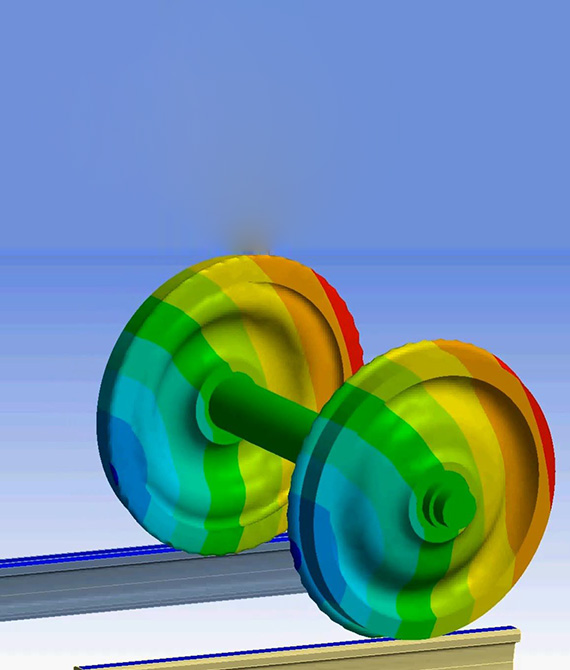
MULTIPHYSICS SIMULATION
Physical laws can be used to describe what happens in the world. We’ve been using computers to explore physical events since the 1940s. Because computing resources were limited in the beginning, physical effects were detected in isolation. However, as we all know, physics does not exist in a vacuum in the actual world.
It’s a Multiphysics World
In nature, the real world is Multiphysics.
Think about your cell phone. The antenna transmits electromagnetic waves, the touch interface or buttons are electromechanical elements that interface with one another, the battery is made up of chemical reactions, ions, electrical current, etc. So, despite being a single device, it is Multiphysics.
You can accurately capture the main components of your design with a Multiphysics simulation tool. CreoTek India is always available to make you understand everything about Simulation tool.

3-D PRINTING AND SIMULATION
Even after making significant progress over the last few years, 3-D printing and simulation still have drawbacks, such as the presence of faults or errors that might lead to a build’s complete failure. As a result, the capacity to model the process in order to correct for and prevent these flaws is critical.
The Need for 3D Printing Simulation
Although codes can theoretically be built to model practically any operation, including material extrusion and binder jetting, the simulation of selective laser melting has recently piqued interest (SLM). A laser is used to specifically melt metal particles in a powder bed in this procedure.
Simulating the 3D printing process, especially with this technology, can help people learn about a variety of topics:
- Build layout: This aids in determining the ideal part orientation, packing efficiency, and whether or not support structures are required.
- Part distortion: In this situation, simulations aid in predicting part deformation during the printing process, which causes a variety of thermo-mechanical changes. For example, the material expands, solidifies, and shrinks due to the changes generated in the powder particles by laser interaction. Such modifications may distort the final product.
- Process-relevant metrics: For production purposes, metrics like as build time and predicted material use, or scrap rates, are used. Simulation software can also give you an idea of how much support material you’ll need and how long it’ll take to complete the process.
- Post-processing planning: Simulation can predict the accumulation of stress and the subsequent thermal post-processing that may be required to release it. Residual stresses will develop and distort the part during the SLM process of the Ti6Al4V alloy, for example. This necessitates the addition of particular support structures in order to get a geometrically precise component.
- Contingencies planning: Simulation can assist in estimating the likelihood of errors that will result in complete failure. Delamination of the part from the building substrate, the appearance of flaws, or porosity formation is all examples of this.
- Process physics: Simulation can aid in the understanding of the development of flaws inside parts, as well as the expected microstructure of a component following the printing process. To compute the expected phase transformations and assess how they will generate distinct microstructures and mechanical properties in metallic components, exaSIM (ANSYS) uses programs that analyze the thermo-mechanical evolution of the component during the SLM process.
ENGINEERING SIMULATION SOFTWARE
Engineering simulation software in the cloud allows you to work on machines and boost development from anywhere, including your home office. When creating new machines, make use of our cloud-based testing environment and enjoy the benefits of our simulation knowledge
ANSYS SIMULATION SOFTWARE
Ansys is a company that creates and sells engineering simulation software for usage across the product life cycle. Ansys Mechanical finite element analysis software is employed to simulate computer models of structures, electronics, or manufacturing equipment to assess strength, durability, elasticity, temperature distribution, electromagnetism, fluid flow, and other characteristics. Ansys simulation is used to evaluate how a product will perform under various conditions without creating test products or doing crash tests.
Simulation software is built on the technique of using mathematical formulas to represent a real-world phenomenon. It’s essentially a program that allows the user to simulate an operation and view it without really conducting it. Simulation software is commonly used to develop equipment so that the end output meets design specifications as closely as feasible without requiring costly in-process modifications. Real-time simulation software is commonly used in gaming, but it also has vital industrial uses. When the cost of incorrect operation is high, such as for airplane pilots, nuclear power plant operators, or chemical plant operators, a mock-up of the actual control panel is connected to a real-time simulation of the physical response, providing valuable training experience without the risk of disaster.


ANSYS DISCOVERY
Ansys Discovery simulation-driven design tool that integrates instant physics simulation, proven Ansys high-fidelity simulation, and interactive geometry modelling in a single user interface. This is an ideal solution for students who are just starting started with simulation since it allows them to learn about physics without having to spend time learning how to utilize a complex simulation tool. Structural analysis, fluid analysis, topology optimization, thermal analysis, geometry modelling, modal analysis, and parameter research are all available.
ANSYS FLUID SIMULATION SOFTWARE
Fluid flow levels, pressure drops, and turbulence are only a few of the variables that might be difficult to predict during design. Engineers may explore more ideas and make better judgments by using CFD modelling to understand these performance metrics.
Performance matters
Excellent performance and dependability speak for themselves and can help you win business. Pumps, valves, heat exchangers, nozzles, and measuring equipment rely on the performance of their fluid flow to determine their success. Engineers must strike the right balance between cost, performance, and dependability while working with limited resources. Engineers must explore more concepts during the design process to achieve this.
DESIGN SIMULATION SOFTWARE FOR CFD
Engineers can use design simulation software for CFD to optimize system design with a variety of powerful tools.
- Thermal management for electronics cooling
- Fluid flow and unrestricted surface movement
- Building Information Modelling (BIM) integration for HVAC occupant comfort in AEC and MEP
Automate design studies for enhanced efficiency
Through the Decision Centre’s customization and automation of typical processes, the Application Programming Interface (API) and scripting functionalities extend Autodesk CFD’s base capabilities. Furthermore, the Decision Center automates system design comparisons in order to speed up design-based decision-making.

ANSYS STRUCTURAL MECHANICAL SIMULATION
Ansys users may repeat and solve their duties while improving the design and decreasing errors, ranging from static structural mechanics to simulation of dynamic effects to parameter and topology optimization. The simulation process is sped up and simplified by using consistent procedures and automation.
You may use Ansys mechanical simulation to tackle complicated structural engineering challenges and make better quicker design decisions. You can tailor and automate solutions for your structural mechanics’ problems using the suite’s finite element analysis (FEA) solvers and customize them to investigate numerous design scenarios. Ansys Mechanical is a dynamic tool with a comprehensive set of analytical capabilities.
- Dynamic, Integrated Platform with Easy-to-Use Multi-Purpose Tool
- Solver Technology that is Consistent, Reliable, and Accurate
- Solvers that are both nonlinear and linear in nature.
Finite Element Analysis, or FEA, is the numerical mathematic approach known as the Finite Element Method, or FEM, used to simulate a physical occurrence. Mechanical engineering and a variety of other fields, rely on this process. It’s also one of the guiding ideas in the creation of simulation software. Engineers can utilize these FEM to cut down on the number of real prototypes needed and undertake virtual experiments to improve their ideas.
Understanding the physical processes that occur all around us necessitates the use of complex mathematics. Fluid dynamics, wave propagation, and thermal analysis are examples of these.
Although partial differential equations may be used to analyse most of these phenomena, Finite Element Analysis is the most often used mathematical technique in complex scenarios involving numerous highly variable equations.
PTC SIMULATION SOFTWARE
CREO SIMULATION
It’s critical to your product development process to use digital prototypes to understand how your designs work in real-world situations. Creo Simulation was created specifically for engineers. It includes solutions for structural, thermal, and vibration analysis, as well as a full set of finite element analysis (FEA) capabilities. Before you construct the first section, you may analyze and validate the performance of your 3D virtual prototypes with Creo Simulation.
CREO FLOW SIMULATION
Creo Flow Analysis extension puts CFD in the hands of every engineer. As products become more complex and timelines shorten, you need a CFD solution that allows you to analyse liquid and gas flow early in your design process. With Creo Flow Analysis (FAE), you can reduce expensive hardware testing and gain unique insight into your products.


CREO SIMULATION LIVE
Creo Simulation Live powered by Ansys Simulation. Creo Simulation Live provides real-time feedback on your design decisions as you work in your CAD environment. You don’t have to predict how your design will perform in real-world scenarios anymore. You iterate quickly, incorporating as many design changes as you desire, secure in your decision-making abilities.
CREO ANSYS SIMULATION
Creo Ansys Simulation powered by Ansys Simulation. The traditional design approach can no longer scale with the demand for cheaper, lighter, faster, and stronger goods that work the first time. This is where simulation-based design and analysis come into play. Designers and engineers can do the following with design simulation:
- Find problems early in the design phase, when they are easier to correct and less expensive.
- Produce higher-quality products at a lower cost of production.
- Allow analysts to concentrate on high-fidelity, sophisticated analyses.
- For more details, contact CreoTek India today!
Would you like to know more?
Creo Ansys Simulation seamlessly integrates the power of Ansys, the leader in engineering simulation, directly into Creo. Built specifically for designers and engineers, this easy-to-use, fully-featured, high-fidelity simulation tool leverages Ansys’ capabilities for thermal, structural, and modal analyses.
